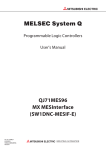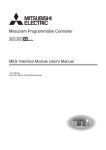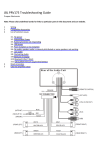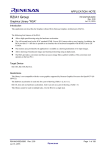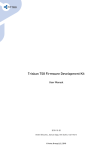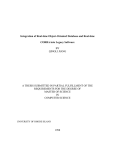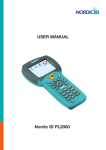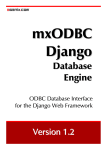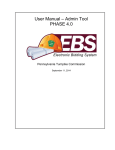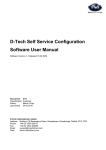Download PLE server SDK User manual
Transcript
PLE Server Application Development Kit
User's Manual
Andrei Birjukov, Ivari Horm
© Artec Group LLC, 2010
PLE Server Application Development Kit
User's Manual
Table of Contents
About This Document.....................................................................................................................................3
Intended Audience..........................................................................................................................................3
Required Skills...............................................................................................................................................3
Conventions....................................................................................................................................................3
References......................................................................................................................................................3
Vocabulary......................................................................................................................................................4
1. Introduction......................................................................................................................................................5
2. Package Contents............................................................................................................................................6
2.1. System Requirements.............................................................................................................................6
3. Installing SADK................................................................................................................................................7
4. PLE Terminal Application Concept..................................................................................................................8
5. Running Demo Applications............................................................................................................................8
6. Architecture of SADK.......................................................................................................................................9
6.1. Application Framework.........................................................................................................................10
6.2. Server Design.........................................................................................................................................12
6.3. Server Configuration..............................................................................................................................13
7. Developing New Applications........................................................................................................................15
7.1 Using Java Persistence API....................................................................................................................17
© Artec Group, 2010
Teaduspargi 6/2, 12618, Tallinn, Estonia
Phone: +372 671 8550
Fax:
+372 671 8555
Page 2 of 19
PLE Server Application Development Kit
User's Manual
About This Document
This manual describes the development kit components and server application development process for
Artec Triskan TS8 mobile data terminal.
Intended Audience
This document is intended for software engineers and system integrators who are planning to develop
PiccoLink ™ compatible applications running on terminal server and hosting Triskan TS8 devices equipped
with PLE firmware.
Required Skills
To use this development kit, a developer must be familiar with the following issues and possess the
following skills.
•
General principles of client-server software architecture and TCP/IP communication
•
Java SE skills and knowledge of API for Java 6
Conventions
This document uses the following conventions.
Courier
Used to identify source code samples, commands and their parameters,
expressions, data types, etc.
Italic
Used for emphasis and identification of file names and new terms.
References
The following documents are referenced from this document.
1.
SADK library API documentation.
2.
PLE Protocol Specification.
PiccoLink ™ is a trademark of Nordic Identification OY.
© Artec Group, 2010
Teaduspargi 6/2, 12618, Tallinn, Estonia
Phone: +372 671 8550
Fax:
+372 671 8555
Page 3 of 19
PLE Server Application Development Kit
User's Manual
Vocabulary
Term
Definition
JDT
Java Development Tools, refers to the Eclipse IDE JDT distribution.
PLE
PiccoLink™ Emulation, refers to a compatible implementation of a terminal
protocol.
RFID
Radio Frequency Identification, refers to RFID reader function of the Triskan TS8
terminal.
SADK
Server Application Development Kit, a library provided by Artec to help
implementing server-side applications for Triskan TS8 terminals.
SIM
Subscriber Identification Module, refers to the GSM SIM card.
© Artec Group, 2010
Teaduspargi 6/2, 12618, Tallinn, Estonia
Phone: +372 671 8550
Fax:
+372 671 8555
Page 4 of 19
PLE Server Application Development Kit
User's Manual
1. Introduction
Basic Triskan TS8 unit comes with the PLE firmware that integrates a terminal emulation application
running a PiccoLink-compatible protocol stack. The Triskan terminal communicates with a server backend
application via GPRS or WLAN bearers. The backend application implements a customer specific business
logic and a database, and provides the presentation interface to Triskan terminals by means of specially
crafted forms sent over a binary PiccoLink compatible PLE protocol.
Server Application Development Kit (SADK) is designed to simplify the development of server applications,
enabling for a rapid deployment of Triskan PLE terminals. The following principles are followed throughout
the development cycle.
•
Simplicity. The server architecture was designed from scratch, allowing for a clean and modular
implementation. The developer is conveniently served with a small number of well-documented
interfaces that are exposed by the SADK.
•
Rapid development. Comfortable Eclipse IDE, local and remote debugging support, Java type
safety, object and interface oriented approach of SADK simplifies development of server
applications.
•
Cross-platform. Being completely portable, the server supports Windows, Linux, Mac OS X and
other OS-es capable of running Java SE virtual machine.
•
UI abstractions. Application developer is not burdened with internals of the communication
protocol. Instead, SADK provides convenient abstractions for application forms and input fields.
•
Multiple online terminals. The server is multi-threaded, enabling for a large quantity of
simultaneous connections without a significant performance penalty. Each Triskan terminal
connection is isolated: incoming data is processed separately, keeping the terminal context on perconnection basis.
•
Context persistence. Application instance with user data may be preserved on the server when a
terminal is disconnected unexpectedly (e.g. due to coverage issues). Upon reconnection, current
form and associated data will be restored automatically.
•
Multiple applications, single server. The server supports many different applications available
simultaneously on one TCP port. Before launch, the specific application is looked up from the
database basing on the terminal serial number.
© Artec Group, 2010
Teaduspargi 6/2, 12618, Tallinn, Estonia
Phone: +372 671 8550
Fax:
+372 671 8555
Page 5 of 19
PLE Server Application Development Kit
User's Manual
•
Self-contained. Java SE runtime and MySQL database driver are integrated into SADK, no other
dependencies are required.
2. Package Contents
SADK is distributed as a ZIP archive file containing all necessary documentation, source code, libraries and
samples. Given below is the list of files included with SADK.
File
Description
doc/manual.pdf
PLE Server Application Development Kit User's Manual (this document)
doc/ple_protocol.pdf
PLE Protocol Specification
doc/sadk-doc.zip
Full documentation for SADK classes.
doc/license.txt
SADK distribution license (MIT license)
src/pleSADK-nn.zip
SADK Java source code with examples
jar/pleSADK-nn.jar
Pre-built SADK library JAR without source code.
jar/pleServer.ini
Server configuration file for stand-alone daemon setup
2.1. System Requirements
Given below are technical requirements for development of server based applications with SADK.
•
PC running Windows XP/Vista/7, Linux (32-bit, 64-bit) or Mac OS X
•
Java 6 SE Development Kit (http://java.sun.com/javase/downloads)
•
NetBeans IDE for Java SE (http://www.netbeans.org/downloads)
-or-
•
Eclipse IDE for Java Developers (http://www.eclipse.org/downloads)
The following is also required to deploy and test developed applications:
•
Triskan TS8 mobile data terminal with integrated GPRS communication module.
•
Operator contract or a prepaid GSM SIM card with GPRS traffic allowed.
•
External IP address with possibility of mapping an inbound TCP port to your development machine
(or private network agreement with a cellular operator).
-or-
•
Triskan TS8 mobile data terminal with integrated WLAN communication module.
•
Standard IEEE 802.11b/g/n access point or router.
© Artec Group, 2010
Teaduspargi 6/2, 12618, Tallinn, Estonia
Phone: +372 671 8550
Fax:
+372 671 8555
Page 6 of 19
PLE Server Application Development Kit
User's Manual
•
Possibility of mapping an inbound TCP port to your development machine.
3. Installing SADK
Extract the provided redistributable package ( sadk-revnn.zip) to any suitable location on your development
machine. Further, extract the SADK source code package located under src/pleSADK-nn.zip. Extract the
library API documentation located under doc/sadk-doc.zip.
Finally, import the SADK projects into your Java development IDE.
For NetBeans IDE for Java SE:
•
Select File → New Project
•
Choose the option “Java Project with Existing Sources”
•
Browse to the location where you extracted the SADK source code (pleSADK-nn.zip).
•
Check the Open as Main Project option and click Open Project
•
Explore the newly appeared pleSADK project – the IDE builds it automatically.
•
The following compile-time libraries must be available for a successful build (Select File → Project
Properties → Libraries):
•
◦
MySQL JDBC connector (mysql-connector-java-NNN.jar)
◦
EclipseLink(JPA 2.0)
Note that default installation from Linux repositories (i.e. Ubuntu) does not include the EclipseLink
nor MySQL JDBC connector.
For Eclipse JDT IDE:
•
Select File → Import → General / Existing Projects into Workspace
•
Click Next and browse to the location where you extracted the SADK source code (pleSADK.zip)
•
Click Finish and explore the newly appeared pleSADK – the IDE builds it automatically.
For further development, you might not need the complete source code of SADK classes. In such case, feel
free to create separate projects for your applications and link them to the pre-built JRE library version of
SADK (pleSADK-nn.jar).
© Artec Group, 2010
Teaduspargi 6/2, 12618, Tallinn, Estonia
Phone: +372 671 8550
Fax:
+372 671 8555
Page 7 of 19
PLE Server Application Development Kit
User's Manual
4. PLE Terminal Application Concept
From a general point of view, an application that employs PLE protocol is based on a client-server model.
The data model and complete business logic of the PLE application reside on the server. User interface of
the application is based on text forms and is rendered on remote Triskan terminals via special messages of
the PLE protocol. The Triskan device thus acts as a simple terminal interpreting server messages and
displaying text as instructed. Also, user input from both terminal keypad and integrated readers is sent
back to the server for further processing.
The following constraints apply to PLE based applications.
•
All applications are inherently on-line, assuming that network connection is available at all times.
•
Server implements full business logic of the application: processes data and makes decisions.
•
All application data is stored in a server database.
•
Terminal screen contains text, rendered via fixed width font.
•
Visible size of the terminal screen contains 20 rows and 8 columns of characters, total buffer size
is 20x12, vertical scrolling is allowed.
•
1D/2D scanner and RFID reader input is redirected to on-screen form fields.
•
Server has limited control of Triskan peripherals.
•
Local storage of Triskan terminal is not accessible to applications.
Firmware of the Triskan terminal takes care of power management and networking, keeping a connection
to server established. These and other basic tasks are running in the background of the terminal and do
not interfere with user applications. Developer does not need make modifications to Triskan firmware and
may concentrate on the application functionality instead; only connectivity related parameters may need
changing.
5. Running Demo Applications
All example application code is located in the ple.application package. There are two samples provided with
this version of SADK.
•
Default application launcher: ple.application
Provides menu entries to launch different applications located in subpackages under this package.
© Artec Group, 2010
Teaduspargi 6/2, 12618, Tallinn, Estonia
Phone: +372 671 8550
Fax:
+372 671 8555
Page 8 of 19
PLE Server Application Development Kit
User's Manual
•
Hotel check-in demonstration: ple.application.checkin
This application implements a simple guest check-in screen. User scans a guest's badge and the
status is sent back to the terminal and reflected in the table of a GUI front-end.
•
Ticket control demonstration: ple.application.checkticket
This application implements a simple ticket validation routine. User scans a ticket ID and the ticket
status is sent back to the terminal. GUI front-end allows adding new tickets.
•
Warehouse inventory demonstration: ple.application.warehouse
Implements a simple inventory solution. Items can be added to warehouse both from the terminal
and GUI front-end. The inventory can later be performed by scanning the item entering the proper
quantity. The checkout routine enables to quickly scan items and reduce their quantity in the
warehouse.
•
Field test demonstration: ple.application.fieldtest
Shows different input fields and their behaviour provided by PiccoLink protocol and implemented in
Triskan TS8 firmware.
•
Protocol test demonstration: ple.application.protocoltests
Provides demos for testing various PiccoLink protocol capabilities.
The source code of provided demo applications is organized as follows.
•
<PackageName> class – provides the entry point to the application. This class should be specified
in configuration file or called dynamically from another applicaton in order to launch the launch
the application instance.
•
Database class – implements simple data model pattern. If application uses a database the
database to object model mapping is done here.
•
DefaultForm class – the main form that is loaded in Triskan terminal when the application is first
started.
•
Form classes – implement PLE input forms and contain application business logic.
6. Architecture of SADK
SADK library is built in a modular fashion. It provides a number of classes to build a PLE application server
that hosts a user application. Also, user is provided with flexible forms and plugin libraries that create a
foundation for building diverse hosted applications. The diagram below illustrates a top-level overview of
the SADK stack with relationship to external Java VM and SQL database.
© Artec Group, 2010
Teaduspargi 6/2, 12618, Tallinn, Estonia
Phone: +372 671 8550
Fax:
+372 671 8555
Page 9 of 19
PLE Server Application Development Kit
User's Manual
Figure 1. General architecture of SADK.
Listed below are packages that the SADK library consists of.
•
ple.server – contains classes and interfaces required to run the PLE server and manage
connections to remote Triskan terminals.
•
ple.data – contains server data related classes: configuration and logging facilities and general
database connector handler that encapsulates Java Persistence routines.
•
ple.protocol – contains classes and interfaces required to decode binary PLE protocol and create
protocol frames.
•
ple.plugin – contains foundation classes and interfaces used to develop user applications hosted
by the PLE server.
•
ple.application – contains examples of PLE applications. Developers may use this package for
own applications as well.
6.1. Application Framework
Triskan SADK proposes an event and form based approach to the application design. The most important
classes of the application framework are FormApplication and Form. All PLE applications are created by
the PLE server and implement a certain interface ( CommandHandler). Through this interface, applications
react to events submitted by the PLE server. Further, the form abstraction layer is added, and protocol
command events are translated to form events and routed to form elements implemented by the Field
class and its subclasses.
Given below is a class diagram illustrating the internal design of the PLE application framework. For
simplicity, class methods and attributes are omitted and only the most important relationships are shown.
© Artec Group, 2010
Teaduspargi 6/2, 12618, Tallinn, Estonia
Phone: +372 671 8550
Fax:
+372 671 8555
Page 10 of 19
PLE Server Application Development Kit
User's Manual
Figure 3. PLE application framework simplified class diagram.
•
Application class provides the base for implementation of all applications hosted by PLE server
which should inherit from this class. Application receives raw protocol command events from the
remote terminals relayed by the PLE server via the CommandHandler interface.
•
FormApplication class builds a form abstraction on top of the Application basis. FormApplication
encapsulates a number of user-defined forms that implement both presentation and business
logic layers of a PLE application. Also, FormApplication transparently calls rendering functions of
contained fields to generate appropriate PLE protocol commands and display forms on the screen
of a Triskan terminal. It is recommended that all user applications are inherited from this class, as
the developer is not bothered with internals of the PLE communication protocol in such case.
•
Form class implements an input form displayed on the screen of a remote Triskan terminal. The
form may contain a number of input fields. The instance of the Form class receives events from an
associated remote terminal translated to a convenient format by FormApplication. All forms of a
form-based application should inherit from this class.
•
Field class implements a base for user input controls of a form displayed on the screen of a
remote terminal. Subclasses of the field class implement buttons ( Button), submit buttons
(SubmitButton), command buttons (CommandButton), text labels (TextField), input fields
© Artec Group, 2010
Teaduspargi 6/2, 12618, Tallinn, Estonia
Phone: +372 671 8550
Fax:
+372 671 8555
Page 11 of 19
PLE Server Application Development Kit
User's Manual
(InputField) and RFID input fields (RfidField). Fields implement functions to “render” themselves on
the screen by creating a sequence of terminal protocol commands.
6.2. Server Design
Given below is a class diagram illustrating the internal design of the PLE application server. For simplicity,
class methods and attributes are omitted and only the most important relationships are shown.
Figure 2. PLE server simplified class diagram.
Normally, a developer does not need to go into details of the PLE server implementation. The server is
started by instantiating the PleServer class and calling initialize() method. The server has configuration
stored to an external file .
Developer may use a stock application factory, such as SingleApplicationFactory or SqlApplicationFactory.
Alternatively, developer may implement a custom application factory and instruct the PLE server to use it
instead.
When using multiple applications, developer can use SqlApplicationFactory to instruct the server to load
the proper application based on the Triskan station ID. To provide access to multiple applications the
© Artec Group, 2010
Teaduspargi 6/2, 12618, Tallinn, Estonia
Phone: +372 671 8550
Fax:
+372 671 8555
Page 12 of 19
PLE Server Application Development Kit
User's Manual
default loader menu can be developed. It is possible to switch applications run-time by calling the special
method.
6.3. Server Configuration
The server reads its configuration from the pleServer.ini file located in the current working directory.
Samples of configuration files are provided in the distributed package. The format of the configuration file
is described below.
Parameter
Description
serverPort
Specifies the TCP port that the PLE server listens on.
idleTimeout
Specifies the idle timeout of a connected PLE terminal, in seconds. The
terminal is disconnected if no new data is received within this time interval.
logFile
Server log file name or full path to file.
applicationMode
Specifies server application hosting mode, applies only to stand-alone daemon
setup. Supported modes are "single" (use one type of applications for all
terminals) and "multi" (use different applications basing on terminal serial
number, look up from SQL database).
applicationClass
Contains the application class for a single application mode. Also specifies the
"default" fallback application class if the server fails to find a matching
application for a connected terminal. When changing applications dynamically,
this is also the default application which is loaded if no application name is
specified for the application switcher.
persistTimeout
Context persistence timeout of a disconnected PLE terminal, in seconds. NB!
This option is only available to applications that use application factories with
persistent pools (e.g. MemoryPersistentPool).
sqlUrl
Contains the JDBC URL pointing to a server database for application class
lookup. Applicable only to the multi-application mode of operation and when
using Java Persistence API.
sqlUser
Contains a user name for authorization to the JDBC database.
sqlPasswd
Contains a password for authorization to the JDBC database.
charMapMid
Sets the character map to use for codes (128...159).
charMapCode
Sets the character map to use for codes (160...255).
•
Character map settings do not change the character map in the terminal but provide reasonable
defaults for custom character map configurations.
© Artec Group, 2010
Teaduspargi 6/2, 12618, Tallinn, Estonia
Phone: +372 671 8550
Fax:
+372 671 8555
Page 13 of 19
PLE Server Application Development Kit
User's Manual
•
SQL settings specified here are used both when application mode is set to “multi” as well as for
Java Persistence API. Note that when developing database applications the Java Persistence API is
configured using the META-INF/persistence.xml file. Nevertheless, the database server name,
user name and password can also be obtained from the pleServer.ini file.
© Artec Group, 2010
Teaduspargi 6/2, 12618, Tallinn, Estonia
Phone: +372 671 8550
Fax:
+372 671 8555
Page 14 of 19
PLE Server Application Development Kit
User's Manual
7. Developing New Applications
The class diagram below illustrates the structure of a sample ticket validation application (see
ple.application.ticket package). This example is reviewed here for better understanding of the PLE
application design.
Follow the steps below to build a new integrated application hosted by the PLE server.
1.
Create a new application class (e.g. YourApplication) and derive it from FormApplication.
import ple.plugin.FormApplication;
© Artec Group, 2010
Teaduspargi 6/2, 12618, Tallinn, Estonia
Phone: +372 671 8550
Fax:
+372 671 8555
Page 15 of 19
PLE Server Application Development Kit
User's Manual
public class YourApplication extends FormApplication {
}
2.
Create a new initial form class (e.g. MainForm) and derive it from Form. Create a suitable
constructor to instantiate the form with a concrete identifier. The form identifier must be unique
for each kind of form.
import ple.plugin.Form
public class MainForm extends Form {
private static final int FORM_ID = 1;
public MainForm(FormApplication app) {
super(FORM_ID, app);
}
}
3.
Override the processInitial() function in YourApplication class to create and render MainForm.
@Override
public void processInitial() {
Form f = new YourForm(this);
f.render();
}
4.
Override the onInitialize() function in MainForm class to create user interface fields.
@Override
private inputField;
protected void onInitialize() {
addField(new TextField(0, "
-- Welcome --
"));
addField(new TextField(60, "Enter text:"));
addField(inputField = new InputField(80, 16));
addField(new Button(148, "[OK]"));
}
5.
Override the processFieldData() function or processComplete() function in MainForm class to
respond to terminal input events.
@Override
protected void processFieldData(Field f) {
if (f == inputField) {
// process data here
String data = f.getData();
© Artec Group, 2010
Teaduspargi 6/2, 12618, Tallinn, Estonia
Phone: +372 671 8550
Fax:
+372 671 8555
Page 16 of 19
PLE Server Application Development Kit
User's Manual
}
}
6.
Instruct the PLE server to launch your application by defining the application class in the server
configuration file.
applicationMode=single
applicationClass=your.package.YourApplication
If you prefer to run your application stand-alone as a desktop program, follow the steps below to build a
GUI front-end for the PLE server.
1.
Create a new desktop application class with main() entry point.
2.
Develop your GUI front-end class using Java Swing, AWT or any other GUI toolkit.
3.
Launch the PLE server by creating an instance of PleServer class and calling its initialize()
function.
private PleServer pleServer;
try {
pleServer = new PleServer();
pleServer.initialize();
} catch (PleServer.ServerException e) {
// error processing
}
7.1 Using Java Persistence API
The Java Persistence API (JPA) can be used to provide database storage for the applications.
1.
Create the META-INF/persistence.xml file with the proper configuration:
<?xml version="1.0" encoding="UTF-8"?>
<persistence version="1.0" xmlns="http://java.sun.com/xml/ns/persistence"
xmlns:xsi="http://www.w3.org/2001/XMLSchema-instance"
xsi:schemaLocation="http://java.sun.com/xml/ns/persistence
http://java.sun.com/xml/ns/persistence/persistence_2_0.xsd">
<persistence-unit name="default" transaction-type="RESOURCE_LOCAL">
<provider>org.eclipse.persistence.jpa.PersistenceProvider</provider>
<class>ple.application.MyPackage.EntityClassName</class>
<properties>
© Artec Group, 2010
Teaduspargi 6/2, 12618, Tallinn, Estonia
Phone: +372 671 8550
Fax:
+372 671 8555
Page 17 of 19
PLE Server Application Development Kit
User's Manual
<property name="javax.persistence.jdbc.driver"
value="com.mysql.jdbc.Driver"/>
<property name="javax.persistence.jdbc.url"
value="jdbc:mysql://localhost:3306/table_name"/>
<property name="javax.persistence.jdbc.user" value="db_user"/>
<property name="javax.persistence.jdbc.password"
value="db_password"/>
</properties>
</persistence-unit>
</persistence>
2.
Note that the persistence unit name must be used below to select proper database connection. The
persistence unit with name “default” can be used as a fallback solution when actual unit is not
found. The server connection URL, user name and password fields are optional. If the pleServer.ini
file contains valid credentials they will be used instead.
3.
Create entity classes that provide object-relational mappings. Note that all entity classes that have
JPA annotations mus be specified by <class></class> attributes:
@Entity
@Table(name="badges")
public class Badge implements Serializable {
@Id
@Column(name="id", nullable=false)
private String id;
@Column(name="checkInDate")
@Temporal(TemporalType.TIMESTAMP)
private Date checkInDate;
@Column(name="checkOutDate")
@Temporal(TemporalType.TIMESTAMP)
private Date checkOutDate;
@Column(name="description")
private String description;
public Badge() { }
public Badge(String id) {
this.id = id;
© Artec Group, 2010
Teaduspargi 6/2, 12618, Tallinn, Estonia
Phone: +372 671 8550
Fax:
+372 671 8555
Page 18 of 19
PLE Server Application Development Kit
User's Manual
}
}
4.
Create the database model class that implements database-to-object mapping:
import ple.plugin.Application;
import ple.data.DBConnector;
public class Database {
private DBConnector db;
public Database(Appliction app) {
}
}
5.
Get the database connector instance from the terminal session and store it inside the class. Also
select the proper persistence identity from META-INF/persistence.xml to use with the application.
Example applications use package name as the identity string. The package name can be obtained
using the this.getClass().getPackage().getName() call.
public class Database {
private DBConnector db;
public Database(Appliction app) {
db = app.getTerminal().getDB();
db.selectDB(getClass().getPackage().getName(),”database_name”);
}
}
The selectDB() method accepts the database name as a last argument. If the database name is
specified, the server properties in META-INF/persistence.xml are ignored and database settings
from pleServer.ini will be used instead.
6.
Create the methods to retrieve the data from database and store them with entity models (e.g
Badges) etc.
© Artec Group, 2010
Teaduspargi 6/2, 12618, Tallinn, Estonia
Phone: +372 671 8550
Fax:
+372 671 8555
Page 19 of 19




















